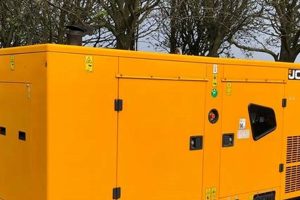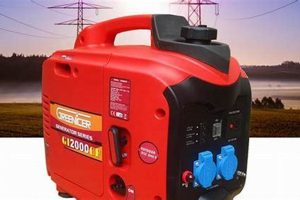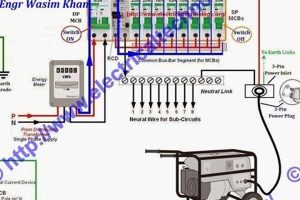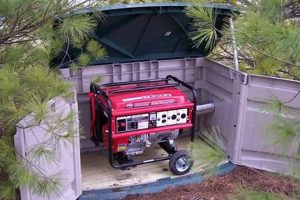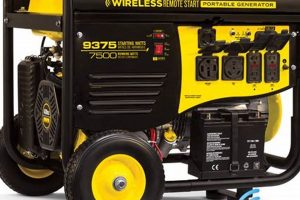A compact, mobile power source can provide the electricity necessary for residential cooling systems during power outages or in off-grid locations. This allows homeowners to maintain a comfortable indoor temperature even when traditional power sources are unavailable. For instance, during a summer storm, a suitably sized unit can keep a home cool until utility power is restored.
Maintaining comfortable temperatures during power outages is critical for health and safety, especially for vulnerable populations like the elderly and infants. This capability offers peace of mind and improves quality of life during emergencies. Historically, relying solely on utility power meant homes were vulnerable to temperature extremes during outages. The advent of compact power generation technology has provided a valuable solution for climate control independence.
The following sections will explore the key factors to consider when selecting a suitable power source for a residential cooling system, including sizing requirements, fuel types, and safety precautions.
Tips for Using a Generator for Central Air Conditioning
Careful planning and execution are essential when using a generator to power a central air conditioning system. The following tips provide guidance for safe and effective operation.
Tip 1: Accurate Power Sizing is Crucial: Air conditioners require significant starting wattage, often several times their running wattage. Generator capacity must accommodate this surge. Consulting an HVAC professional is recommended to determine precise power needs.
Tip 2: Proper Generator Placement: Generators produce carbon monoxide, a deadly gas. Units must be placed outdoors, far from windows and doors, to ensure proper ventilation and prevent hazardous fumes from entering the home.
Tip 3: Safe Fuel Handling: Always allow the generator to cool completely before refueling to prevent fire hazards. Store fuel in approved containers and in a well-ventilated area away from ignition sources.
Tip 4: Regular Maintenance: Generators require regular maintenance, including oil changes and air filter cleaning, to ensure reliable performance. Consult the manufacturer’s instructions for specific maintenance schedules.
Tip 5: Professional Installation Recommended: Connecting a generator to a home’s electrical system requires technical expertise. Incorrect wiring can damage appliances and pose safety risks. Professional installation by a qualified electrician is highly recommended.
Tip 6: Consider a Transfer Switch: A transfer switch safely connects the generator to the home’s electrical system, preventing backfeeding which can endanger utility workers. This also simplifies the process of switching between generator and utility power.
Tip 7: Weather Protection: Protect the generator from the elements. While most are designed for outdoor use, providing additional cover can extend its lifespan and maintain reliable operation.
Adhering to these guidelines ensures the safe and effective use of a generator for central air conditioning, providing reliable comfort during power disruptions. These precautions safeguard both the home and individuals from potential hazards.
By understanding the importance of proper sizing, safe operation, and regular maintenance, homeowners can effectively utilize a generator for central air conditioning, maximizing comfort and safety during power outages.
1. Power Requirements (Wattage)
Accurately determining power requirements is paramount when selecting a portable generator for central air conditioning. Insufficient wattage prevents the air conditioner from starting or operating correctly, potentially leading to system damage or generator overload. The critical factor is the air conditioner’s starting wattage, which can be significantly higher (two to three times) than its running wattage due to the initial surge required by the compressor motor. For example, a central air conditioner with a 3,000-watt running wattage might require a starting wattage of 9,000 watts. Therefore, the generator’s capacity must exceed the air conditioner’s starting wattage to ensure reliable operation.
Overlooking starting wattage can lead to frustrating and costly consequences. A generator with insufficient starting wattage will struggle to power the air conditioner, potentially tripping the generator’s breaker or causing damage to the AC unit’s compressor. Furthermore, underpowered generators may operate inefficiently, consuming more fuel and producing excessive noise. Conversely, an oversized generator, while functional, represents unnecessary expense and fuel consumption. Practical application of this understanding involves consulting the air conditioner’s specifications or an HVAC professional to determine precise starting and running wattage requirements before selecting a generator.
In summary, precise wattage calculations are crucial for successfully operating a central air conditioner with a portable generator. Understanding the distinction between starting and running wattage, and the potential ramifications of incorrect sizing, allows for informed generator selection. This ensures reliable air conditioner operation during power outages while preventing equipment damage and optimizing generator efficiency. Consulting manufacturer specifications or seeking professional guidance provides the necessary information for effective power planning. This ultimately leads to a more resilient and comfortable environment during power disruptions.
2. Generator Portability
Generator portability is a critical factor when considering using a portable generator to power a central air conditioning system. Portability encompasses not only the generator’s physical dimensions and weight but also features that facilitate maneuverability and storage. These factors directly impact the practicality and ease of use in various scenarios, including emergency power outages and recreational activities. The following facets explore the key components of generator portability and their implications for powering central air conditioning.
- Physical Dimensions and Weight
The generator’s size and weight dictate ease of transport and storage. Compact, lightweight units are easier to move and store, while larger, heavier models may require assistance or specialized equipment. For central air conditioning, the necessary wattage often necessitates a larger generator, posing potential challenges for portability. Consider the pathways and storage spaces available when selecting a generator. A compact design might be crucial for navigating tight spaces or for individuals with physical limitations.
- Wheels and Handles
Integrated wheels and handles are essential features for convenient transport, particularly for heavier generators. Durable, well-designed wheels facilitate movement over various terrains, while ergonomic handles provide a comfortable and secure grip. The presence and quality of these features significantly impact the practicality of using the generator for central air conditioning, especially in emergency situations requiring quick deployment.
- Folding Handles and Compact Design
Folding handles and compact designs maximize storage efficiency. These features reduce the generator’s footprint, allowing for convenient storage in sheds, garages, or vehicles. The ability to easily store the generator contributes to its overall practicality and accessibility when needed for powering central air conditioning during power outages.
- Lifting Points and Placement
Strategically placed lifting points and a stable base are crucial for safe and efficient handling, particularly for larger generators. Secure lifting points allow for safe transport using cranes or other lifting equipment. A stable base prevents tipping during operation and transport, ensuring safety and preventing damage. These considerations are especially important for generators powering central AC units, given their potential size and weight.
Careful evaluation of these portability facets ensures the selected generator aligns with individual needs and circumstances. Balancing portability with the required power output for central air conditioning is crucial for maximizing practicality and ensuring ease of use during power outages or other situations where a reliable power source is essential. A well-chosen portable generator provides both the necessary power and the convenience required for maintaining comfortable indoor temperatures, regardless of external power availability. This balance allows for effective climate control in various settings, enhancing comfort and safety.
3. Fuel Type and Efficiency
Fuel type and efficiency are critical considerations when selecting a portable generator to power a central air conditioning system. Different fuel types offer distinct advantages and disadvantages regarding availability, cost, storage, and environmental impact. Efficiency directly impacts runtime, fuel consumption, and operating costs. Understanding these factors is crucial for selecting a generator that meets specific needs and operating conditions.
Gasoline: Gasoline is widely available and offers a high energy density, allowing for compact fuel storage. However, gasoline has a limited shelf life and can degrade over time, potentially causing carburetor issues. Gasoline-powered generators are generally more affordable but can produce higher emissions compared to other fuel types. For instance, during extended power outages, gasoline availability might become an issue, while its storage requires careful handling due to flammability.
Propane: Propane offers a longer shelf life than gasoline and burns cleaner, producing fewer emissions. Propane generators often operate more quietly and require less frequent maintenance. However, propane requires larger storage tanks and might be less readily available than gasoline in certain areas. A propane-powered generator might be ideal for homeowners seeking a cleaner and quieter option, provided they have adequate propane storage and access to refills.
Diesel: Diesel generators are known for their durability and fuel efficiency, offering longer runtimes and lower operating costs. Diesel fuel has a longer shelf life than gasoline. However, diesel generators tend to be more expensive and can produce higher noise levels. A diesel generator might be suitable for extended power outages in remote locations where fuel efficiency and reliability are paramount.
Dual Fuel/Tri-Fuel: Some generators offer the flexibility of operating on multiple fuel types, such as gasoline and propane or gasoline, propane, and natural gas. This versatility provides options during fuel shortages or varying price fluctuations. However, dual or tri-fuel generators can be more complex and require specific maintenance procedures for each fuel type. A dual-fuel generator could provide a valuable backup solution for homeowners concerned about fuel availability during emergencies.
Efficiency, measured in kilowatt-hours per gallon (kWh/gal), directly affects runtime and operating costs. Higher efficiency generators consume less fuel to produce the same amount of power, resulting in longer runtimes and lower fuel expenses. This factor becomes increasingly important during extended power outages or in off-grid applications. Matching generator efficiency with expected load requirements and usage patterns is crucial for optimizing cost-effectiveness and minimizing environmental impact. Selecting a highly efficient generator, while potentially more expensive initially, can lead to substantial savings over time, particularly for frequent or prolonged use.
The interplay between fuel type and efficiency directly influences the suitability of a portable generator for powering a central air conditioning system. Careful consideration of these factors, alongside power requirements, portability, and safety features, ensures the selection of a generator that reliably and efficiently meets specific needs and operating conditions. Understanding these interconnected elements empowers informed decision-making, leading to a more resilient and cost-effective power solution for maintaining comfortable indoor temperatures during power disruptions or in off-grid environments. This comprehensive understanding contributes to greater preparedness and peace of mind in the face of power uncertainties.
4. Safety Features & Placement
Safe operation of a portable generator powering a central air conditioning system requires careful attention to both inherent safety features and proper placement. These elements are crucial for mitigating potential hazards associated with generator use, including carbon monoxide poisoning, fire, and electrical shock. Overlooking these aspects can lead to serious consequences, impacting both personal safety and property.
Inherent safety features, such as automatic shutoff mechanisms for low oil levels and overload protection, are crucial for preventing generator damage and potential fire hazards. These features act as safeguards against common operational issues, automatically shutting down the generator in critical situations. For instance, low oil levels can cause engine seizure and potential fire, while overload protection prevents electrical damage to both the generator and connected appliances, including the central air conditioning unit. Placement plays a critical role in mitigating carbon monoxide poisoning. Generators produce carbon monoxide, a colorless, odorless, and highly toxic gas. Proper placement outdoors, far from windows, doors, and vents, ensures adequate ventilation and prevents the accumulation of hazardous fumes. Positioning the generator too close to a structure can lead to carbon monoxide entering the building, posing a serious health risk to occupants. Additionally, placement on a stable, level surface prevents tipping and spills, further reducing fire hazards, particularly with gasoline-powered generators.
Practical application of this understanding necessitates selecting a generator with essential safety features and carefully choosing its placement. Consulting manufacturer recommendations for safe operation distances and ventilation requirements is crucial. Furthermore, understanding local ordinances regarding generator placement and noise levels ensures compliance with regulations and minimizes disturbance to neighbors. Failure to adhere to these safety guidelines can lead to dire consequences, including fatalities from carbon monoxide poisoning, fire damage, and electrical hazards. Prioritizing safety and adhering to best practices ensures reliable operation of the central air conditioning system during power outages while safeguarding individuals and property from potential harm. This proactive approach minimizes risks and provides peace of mind during emergency situations.
5. Noise Levels & Regulations
Noise generated by portable generators used to power central air conditioning systems is a significant consideration due to its potential impact on both the immediate environment and broader community. Generator noise levels are typically measured in decibels (dB), and the perceived loudness can vary depending on factors such as generator size, load, and distance from the source. Operating a loud generator can be disruptive to homeowners and neighbors, leading to complaints and potential legal issues. Furthermore, many municipalities have noise ordinances that restrict permissible noise levels, particularly during certain hours. These regulations aim to maintain a reasonable quality of life within the community and prevent excessive noise pollution. Violating these ordinances can result in fines or other penalties. For example, a homeowner operating a loud generator late at night in a residential neighborhood could face complaints from neighbors and potential fines from local authorities.
The practical implications of generator noise levels necessitate careful consideration when selecting a unit intended to power a central air conditioner. Manufacturers typically provide noise level ratings for their generators, expressed in dB. Opting for a quieter generator, such as an inverter generator known for its lower noise output, can mitigate noise pollution and improve community relations. Additionally, strategic placement of the generator, away from windows and other sensitive areas, can further reduce noise impact. Employing noise-reducing enclosures or barriers can also dampen sound propagation. Understanding local noise ordinances is crucial for ensuring compliance and avoiding potential legal ramifications. For instance, a homeowner in a noise-sensitive area might choose a quieter inverter generator and strategically place it behind a noise-reducing barrier to minimize disturbance and comply with local regulations. Failure to address noise levels can result in strained neighborly relations, legal disputes, and financial penalties.
In summary, noise levels are a critical factor influencing the suitability of a portable generator for powering a central air conditioning system. Balancing the need for reliable backup power with the imperative of minimizing noise pollution requires careful consideration of generator specifications, placement strategies, and local regulations. This holistic approach ensures both the functionality of the central AC system during power outages and the maintenance of a peaceful and compliant environment. Overlooking noise considerations can lead to negative consequences, impacting both individual homeowners and the wider community. A proactive and informed approach to noise management contributes to a more harmonious and sustainable coexistence of backup power solutions and community well-being.
Frequently Asked Questions about Portable Generators for Central Air Conditioning
This section addresses common inquiries regarding the use of portable generators for powering central air conditioning systems. Understanding these aspects is crucial for informed decision-making and safe operation.
Question 1: What size portable generator is needed to run a central air conditioner?
Generator size depends on the air conditioner’s starting and running wattage requirements. Consulting an HVAC professional or referring to the air conditioner’s specifications is recommended for accurate sizing. Oversizing or undersizing can lead to inefficient operation or system damage.
Question 2: Can any portable generator power a central AC unit?
Not all portable generators are suitable for powering central air conditioners. The generator’s wattage must exceed the AC unit’s starting wattage, which can be significantly higher than the running wattage. Careful consideration of power requirements is essential.
Question 3: Is it safe to run a central air conditioner on a portable generator?
Safe operation requires adherence to safety guidelines, including proper generator placement, ventilation, and fuel handling. Carbon monoxide poisoning is a serious risk if generators are not operated outdoors in well-ventilated areas.
Question 4: How long can a portable generator run a central AC unit?
Runtime depends on the generator’s fuel capacity, efficiency, and the air conditioner’s power consumption. Larger fuel tanks and higher efficiency generators generally provide longer runtimes. Fuel type also influences runtime.
Question 5: What type of fuel is best for a generator powering central AC?
The optimal fuel type depends on individual circumstances and priorities. Gasoline is readily available, propane offers cleaner burning, and diesel provides higher efficiency. Dual-fuel options offer flexibility.
Question 6: Are there any legal restrictions on using a portable generator for central AC?
Local ordinances may regulate generator noise levels and placement. Consulting local authorities is recommended to ensure compliance with regulations and avoid potential fines or penalties.
Careful consideration of these frequently asked questions empowers informed decisions regarding the use of portable generators for central air conditioning. Prioritizing safety and understanding operational requirements ensures both effective cooling and responsible generator usage.
The following section will explore specific generator models suitable for powering central air conditioning systems.
Portable Generator to Run Central Air
Selecting a portable generator to power a central air conditioning system requires careful evaluation of several interconnected factors. Power requirements, fuel type and efficiency, portability, safety features, noise levels, and local regulations all play a crucial role in determining the suitability of a generator for this application. Accurate sizing ensures the generator can handle the air conditioner’s starting and running wattage demands. Fuel considerations influence runtime, cost, and environmental impact. Portability affects ease of use and storage. Safety features and proper placement mitigate risks associated with carbon monoxide poisoning, fire, and electrical hazards. Noise levels and adherence to local ordinances maintain community harmony and avoid potential legal issues. Understanding these elements allows for informed decision-making, ensuring reliable backup power for maintaining comfortable indoor temperatures during power outages or in off-grid locations.
Reliable access to climate control is increasingly vital in a world facing more frequent extreme weather events and potential power grid disruptions. Portable generators offer a valuable solution for maintaining essential comfort and safety during such challenges. Careful planning, informed generator selection, and responsible operation ensure these devices provide critical support when needed most, contributing to greater resilience and preparedness in the face of power uncertainties. Investing in a suitable portable generator and understanding its proper use represents a significant step towards ensuring comfort and safety during unforeseen circumstances. This proactive approach empowers individuals and communities to navigate power disruptions effectively, safeguarding well-being and enhancing overall quality of life.


